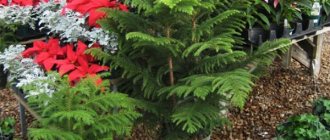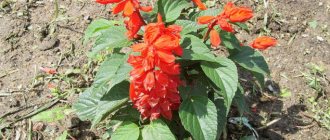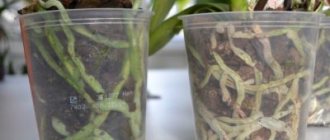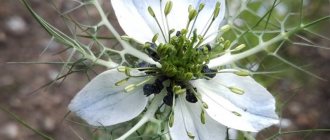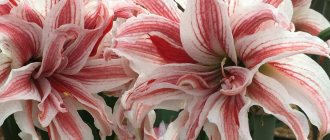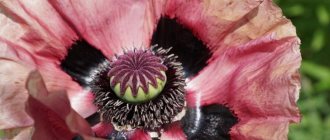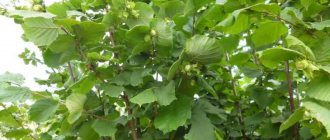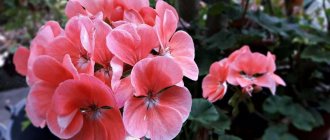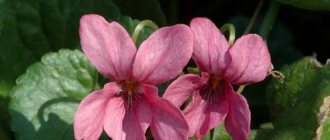It is quite difficult to improve shady places in the garden. The fact is that a relatively small number of crops are known that grow and develop normally in such conditions. If a shady place is located near a large tree, then the soil in such a place, as a rule, is not highly fertile and also has high humidity. To successfully landscape such a place, you need to think carefully. To arrange shady ledges or corners located in the northern part of the garden, it is recommended to use fern, ivy or periwinkle. Such crops feel great even in very dark areas. If you want more variety, then you can look among other shade-tolerant crops, but it is better to choose perennials that are unpretentious to growing conditions.
There are quite a lot of crops that grow well in sunny areas. But you will have to look for shade-loving varieties. At the same time, most species can grow in a partially shaded place with poor sunlight, but the bushes do not bloom so luxuriantly or the foliage becomes faded. Crops planted near shrubs and trees or growing near the northern wall of a building are found in precisely these conditions.
Ferns
Ferns thrive in a shaded area, but they need moderately moist soil. The following types of ferns are most popular among gardeners:
- male shieldweed;
- common millipede;
- the bladder is fragile;
- common ostrich;
- multirow spinous.
Common ostrich
Brittle bladderwort
What plants to plant in shady areas
Sod plants
Below we will describe in detail perennial ground cover plants that cover the ground and are shade-tolerant.
European hoofweed, ivy and periwinkle
European ungulate
Common Ivy Periwinkle
Ivy, common periwinkle and European hoofweed do not need much light to grow properly. Nutritious soil with high humidity is best suited for growing them, but they can grow in worse conditions. Such crops, even when grown in a shady place, grow and develop within normal limits.
Creeping tenacious
Such a perennial plant as creeping tenacious grows in large groups. It forms creeping shoots under the soil surface, which is why it is often used to protect the soil from landslides. The tenacious plant grows well in shade.
During flowering, the bush is decorated with small blue flowers, which are part of the spike-shaped inflorescence. Flowering occurs in May–August. Varieties with reddish-brown foliage are often grown in gardens.
Fragrant bedstraw
The shade-tolerant fragrant bedstraw blooms in April, and flowering ends in June. Its small flowers are collected in cluster-shaped inflorescences. Bedstraw has an aroma similar to hay.
Pachysandra apex
Such an evergreen plant as pachysandra apex is also called Japanese milk. Flowering is observed in May, and the flowers do not have any decorative value. This shade-loving crop can be used to improve the area under trees. The bushes grow strongly, covering the ground with a beautiful green carpet.
Spleen
Belonging to the Saxifraga family, the shade-tolerant spleen has both perennial and annual varieties. This culture received such an unusual name because it is used for diseases of the spleen. Perennial varieties prefer to grow in moist soil. Their shoots are decorated with evergreen leaf blades that are leathery to the touch. Flowering is observed in May; small star-shaped flowers appear on the bush. They are painted white, with a red central part. The flowers are part of loose panicle-shaped inflorescences.
Saxifraga shadow
Perennial saxifrage shady has a small compact bush. It often forms a rather extensive turf that does not bloom. This plant is most widespread in the Northern Hemisphere. Lush inflorescences consist of small pink flowers. This flower prefers to grow in partial shade, and nutritious and moist soil is most suitable for it. Saxifraga can form dense, extensive thickets that are highly decorative.
Plants for shade and partial shade. Shady garden
Overview of species of shade-loving plants
Despite the exceptional importance of sunlight in the life cycle of plants, there are those that grow in the shade. But we must not forget that for a particular plant, different degrees of shading are suitable. If you decide to plant shade-loving plants on your site, then take seriously the choice of the place where it will grow.
There are, of course, fewer shade-loving plants than light-loving plants, but caring for the latter is also more labor-intensive. Moreover, most shade-loving plants are perennials, so planting a flower or shrub in an unsightly shaded area will prevent you from having to plant something new every year.
Trees growing in the shade
Not only flowers and bushes can grow in the shade, but also trees. Shade-loving trees include:
European or forest beech
It grows quickly, is unpretentious to watering and quite frost-resistant, so it will take root in cold regions. Since the tree does not need a lot of sunlight, it grows well in partial shade. European beech is a long-lived tree and will decorate your garden for many years.
Common ash
A fast-growing tree, plant it in an area with indirect shade. It is not afraid of dry weather and thanks to this it will take root in regions with little rainfall. Moreover, ash’s frost resistance increases with age.
Mountain ash
It grows quite quickly, but it is worth noting that rowan is picky about care. Therefore, it is best to plant rowan in a place with diffused light.
Elm
The tree grows quickly. Due to the fact that elm is not afraid of saturated shade, you can safely plant it in a shady place. In addition to the fact that elm is not picky in care, it is also not afraid of low temperatures; it will take root in a region with a cold climate. Plus, elm is a long-lived tree.
Canadian hemlock
Although the tree grows slowly, it does not require abundant sunlight and is unpretentious in care. Hemlock is an evergreen tree, but it has average resistance to frost and is most afraid of snow on its needles. Canadian hemlock is also a long-lived plant.
Shade-tolerant shrubs
In addition to trees, there are many shrubs that thrive in the shade.
Common wolfberry
This shrub begins to turn green with the onset of a thaw and is covered with lilac, less often white or pink inflorescences. It has a subtle, sweet aroma. Wolfberry will decorate your garden with its appearance in those places where sunlight is a rare guest. But be careful, this plant is poisonous and can cause serious poisoning if ingested.
Hydrangea
In Japan they call her “the dreamer of water.” This is a beautiful shrub that blooms with large flowers, the palette of which varies from white to dark purple. From a large number of varieties, you can choose a hydrangea that suits your preferences. Landscape designers often use this bush to decorate the area.
Rhododendron
It is also called the “rose tree”, all because its large pink inflorescences resemble a rose. The homeland of this bush is North America. Initially, rhododendron grew on the shaded, northern slopes of coastal zones, so it is not afraid of either dampness or shade.
Holly holly
This shrub attracts gardeners with its appearance; it has carved, jagged leaves, dense and glossy. Closer to autumn, bright red berries appear on it, which contrast with the lush greenery. Holly is considered a Christmas plant; in the West, houses are decorated with it for New Year and Christmas.
Fuchsia
This plant will decorate your garden plot with flowers shaped like a lantern. The color of the lanterns is bright pink and white, but there are also variations. Fuchsia does not tolerate direct sunlight, so it is suitable for growing in places with diffused light and in the shade.
Boxwood
This evergreen shrub is used by landscape designers to create hedges. Unpretentious, grows quietly in places with minimal sunlight. It has small, hard leaves, glossy and smooth to the touch. It tolerates cutting painlessly, thanks to which you can give this bush any shape.
Aucuba japonica
The homeland of this shrub is Asia, but our gardeners love it for the unusual yellow-green color of the leaves. From a distance it seems that the leaves of this plant have been poured with gold, hence the second name “golden tree”. The leaves have an oblong shape with a pointed tip.
Azalea
This is a small shrub with highly branched branches that blooms with large, beautiful flowers. Azalea is a plant of the rhododendron family and, like its relative, rhododendron attracts attention with its grace and lush flowering.
Euonymus Fortune
An evergreen, low shrub attracts the attention of gardeners with its unusual leaf color. Variegated, yellow-green leaves have long been loved by landscape designers for their originality and fresh appearance. Unpretentious and frost-resistant, it will please the eye at any time of the year.
Decorative foliage plants for shade and partial shade
To landscape areas in the shade, gardeners grow deciduous plants that do not particularly need the rays of the sun. Such plants include:
Khosta
Hosta or funkia does not require painstaking care, but you need to know the basics of its cultivation. Funkia grows well in a shaded place. Although the plant loves moisture, the hosta will also take root in dry areas. It is worth noting that when growing in the shade, the hosta acquires large sizes. In addition, the reproduction function and process is quite simple.
Fern
This is a perennial crop that is also not afraid to grow in a place with scattered shade. Fern care is simple and the most important thing for this plant is proper watering. Plus, at some point the fern may go wild and there will be almost no need to care for it. It is also not necessary to feed the plant. The frost resistance of ferns depends on the species.
Tenacious
As its name suggests, this perennial plant can take root anywhere and will grow with any care. Wherever it is planted, particularly in the shade, the tenacious plant will grow quickly.
But it is important to remember that weak plants are not tenacious neighbors. She just might destroy them. There are no care notes, as such, because the tenacious plant will adapt to any soil and any climate.
Cuff
The most common plant for garden decoration. Unpretentious to care, perennial cuff will help complete garden compositions. Plus, the cuff likes a place with partial shade, where it will bloom beautifully all summer and even autumn.
Kopyten
Hoofweed is one of those plants that does not need sunlight at all, and this plant must be planted in a place with partial shade or deep shade. Hoof care involves moderate watering and replanting, which should be done in the fourth year of growth. Kopten is a real find for those who want to decorate the garden with a green carpet.
Shade-tolerant flowers
Decorating a garden where shade reigns is easy. You just need to know what flowers they like and grow in the shade.
Aquilegia
Popularly known as “catchment”. Aquilegia flowers have an unusually beautiful shape and a very diverse palette of colors; the flowers are: yellow, white, lilac, pink, purple. Flowering period June-July. Loves shaded places.
Anemone
This flower is loved by gardeners for its huge selection of colors; it is so large that it would take a long time to list them. It is worth noting that among the huge number of species, anemones also differ in their fastidiousness to care. The most important thing for an anemone is proper watering and the right place in partial shade.
Begonia everblooming
Perhaps the most popular plant for growing at home. Ever-blooming, begonia is called because of its flowering period, from early summer to mid-autumn. Since in the wild the plant grows in the shade, in the garden begonia can be planted in a place with diffuse shade.
Astilbe
In the wild, astilbe grows in forests and where summer humidity is above average. Depending on the species, the plant can reach different heights, even 2 meters.
Primrose
An unpretentious plant that will grow well in a shaded place. Primrose is divided into about 500 species and each of them is unique.
Lungwort
Also refers to shade-loving plants. Lungwort decorates the garden already in the first days of spring, and all thanks to its beautiful flowering. If you want the plant to decorate your garden for a long time, you should water it regularly.
Periwinkle
A creeping carpet of blue flowers will perfectly complement your garden. Periwinkle is not demanding in care and even in watering, which should only be done in very dry weather,
Siberian iris
Iris or, as it is also called, Siberian iris has the highest endurance of all other species. Siberian iris does not require painstaking care, so if you plant it in a place with diffuse shade, you don’t have to worry about the condition of the plant.
Lily of the valley
In the first days of spring, lilies of the valley are already beginning to bloom in your garden. The plant is easy to care for, but it requires regular feeding and watering.
Dicentra
This annual plant will become the highlight of your garden thanks to its unusual shape. It will be possible to observe the beauty of dicentra flowering from late spring to early autumn, but in order to achieve this, it is necessary to water it correctly.
Kupena
Seal of Solomon or kupena does not need direct sunlight at all, so the plant will bloom only in shaded areas. The main thing in caring for a bathhouse is watering, which should be regular.
Hydrangea
Huge hydrangea inflorescences have never spoiled the garden, especially since tree hydrangea blooms from mid-summer to autumn. The most important thing for hydrangea is generous and regular watering. For normal growth, a place with diffuse shade is suitable.
Hydrangea largeleaf
Before planting large-leaved hydrangea in your garden, understand that the appearance of this beautifully flowering shrub requires the most painstaking care. Hydrangea does not tolerate direct sunlight. In addition, the soil on which hydrangea grows should always be moist.
Buzulnik toothed
Such a sophisticated plant as jagged buzulnik will decorate an unsightly shaded place in your garden. A special feature of the buzulnik is its undemanding ability to change its place of growth. The only thing without which the plant will die is without abundant watering.
Liriope muscari
This is the most popular type of liriope among gardeners. Unlike other shade-loving plants, liriope blooms in autumn.
Japanese schizophragma
The first couple of years it grows slowly, but with proper care the growth rate increases. Schizophragma is a fairly frost-resistant plant, but is afraid of dry weather.
Spiraea japonica
Spiraea is most often used by gardeners to frame garden elements. It does not bloom for long - from mid to late summer. Watering depends on the age of the plant. It is worth noting that Japanese spirea does not suffer from anything.
Fragrant violet
The violet is respected by most garden designers for its primitive beauty, namely its purple flowers. Based on the name, fragrant violet will fill the garden with a pleasant aroma. Moreover, violet is a fairly independent plant and does not require careful care.
Red lungwort
This type of lungwort grows quite quickly. It is worth noting that although the red lungwort has high frost resistance, it would be a good idea to cover it in a cold region.
Noble liverwort
This is the plant that will bloom almost immediately as soon as the snow begins to melt. It is not fussy to care for, but it desperately needs mulching and moderate watering.
Hellebore
Despite their name, young hellebores can die in winter and should be covered. Hellebore blooms early, from late winter to mid-spring; in dry and hot weather it needs watering.
Doronicum eastern
This plant is not suitable for growing alone because after spectacular flowering, Doronicum orientalis sharply loses its external beauty and sheds its leaves. But doronicum eastern is also easy to care for, and for normal growth it needs the right place and regular watering.
Primrose fine-toothed
Multi-colored flowers of primrose or fine-toothed primrose will decorate your garden, although they bloom only for one month of spring. The main thing in caring for serrated primroses is timely watering and proper preparation for wintering.
Volzhanka vulgare
The advantages of Volzhanka or Arunkus make a strong impression, because Volzhanka vulgare is not picky about care, grows well in the shade, has high resistance to frost and will make an excellent decoration.
Black cohosh
The peculiarity of this plant is its rather specific smell. In Germany, the crow is called the silver candle because of the appearance of its fluffy flowers. Does not require painstaking care.
Japanese anemone
The flowers have a light pink tint, which can be achieved with proper care of the Japanese anemone. In summer it is very important to water the plant, and before winter the anemone should be wrapped.
Lady's slipper
Although such an orchid will decorate the garden, for this you need to know how to properly care for the lady’s slipper. The plant needs special soil, a shaded place, shelter for the winter, fertilizing and moderate watering.
Shade-tolerant herbs
To improve the design of your garden plot, use ornamental grasses.
Ozhika snowy
A beautiful, evergreen grass with narrow, long leaves. Recommended for decorating rock gardens. It blooms with white flowers in May - June. Loves shade and moisture.
paniculata
A low, cushion-shaped plant with long and narrow needle-like leaves. Blooms in June - July.
Sedge
This plant is often used to decorate areas with diffused light and shade. Perennial. Very popular in Asian countries.
Bulbous and tuberous plants for semi-shady positions
Often areas in the shade are decorated with the following plants:
Snowdrops
These flowers appear on your site when there is still snow and are rightly called the harbingers of spring. This is a perennial plant 10-15 centimeters in height with white flowers.
Dodecatheon vulgaris
This flowering plant is easy to care for. It has a very beautiful flower shape. Considered a primrose. Flowering begins in May and continues until the end of July and beginning of August.
Corydalis
A low, herbaceous plant, with beautiful and unusual flowers of bright red color with unusual inflorescences. It is very popular among gardeners for its unpretentiousness.
Checkered hazel grouse
Perennial plant, 15 - 20 centimeters high. Its flowers are shaped like a tulip, but have an unusual, spotted color. Completely unpretentious and does not require special care.
Sod plants
Sod or ground cover shade-loving plants:
European ivy
A beautiful evergreen vine. It is planted in the shade near the walls of houses or near large trees. Ivy climbs beautifully with the help of adventitious roots or climbs along the soil cover.
Fragrant bedstraw
A favorite of Dutch and English gardeners. It grows in a thick carpet over the soil, attracting attention with its beautiful, star-shaped shape and small, white flowers. Exudes a pleasant, fresh aroma.
Pahesandra apex
The homeland of this plant is Japan. It is not whimsical and grows over large areas in one season. Low, about 20 centimeters in height, has dense dark green leaves collected in a rosette.
Spleen
A nice plant, the leaves of which are shaped like clover leaves and yellow-green in color, which creates a golden dusting effect. Looks very nice when decorating shady areas.
Saxifraga shadow
As it grows, it forms a thick carpet, the leaves are hard and collected in a rosette. It blooms with small, pink flowers, and the flowering stem rises above the green part at a distance of 20 centimeters.
Fruit trees, shrubs and vegetables
In addition to ornamental plants, fruit trees, shrubs and vegetables can be grown in the shade.
Currant
A low shrub with tasty and healthy berries. Currants can be black, red and white. Grows well in shaded areas and is unpretentious.
Gooseberry Yoshta
A popular garden plant with large green, yellowish-white or red berries. Looks good in the garden interior and requires virtually no maintenance. Yoshta is a hybrid of gooseberry and black currant.
Blueberry
This plant loves a cool, damp climate, so it will take root well in a place with a lack of sunlight. Its fruits are dark blue in color and incredibly healthy.
Hazel
It is also called “hazelnut”. Quite a tall shrub, shade-loving and unpretentious. It bears fruit in small inflorescences containing from 3 to 6 nuts.
Raspberries
We value raspberries for their taste and beneficial properties; not only raspberries, but also their leaves and stems are used in medicine. In addition, she is easy to care for and loves places with diffused light.
Blackberry
A relative of raspberries, they are similar not only in appearance, but also in the beneficial properties of the plants. There are two types of blackberries: creeping and bush (ozhina).
Chokeberry
Popularly called “chokeberry”. This plant is perfect for decorating an area; it looks like a spreading shrub or low tree, with healthy, dark blue fruits.
Dogwood
Dogwood means “red”, it was named so due to the bright red color of the berries. The berries themselves are quite large and have a large seed inside. Grows and bears fruit well in shaded areas.
In addition to fruit-bearing shrubs, vegetables and herbs such as:
- parsley
- cilantro
- garlic
- onion
- sorrel
- wild garlic
- mint
- peas
- beans
- cauliflower
- broccoli
- radish
Herbs that tolerate shade well
In shaded areas, some herbaceous crops do quite well. Shade-loving herbs will be described in more detail below.
Ozhika forest and snow
Ozhika snowy
Ozhika forest and snowy is a perennial shade-tolerant plant that is quite popular among gardeners. It is often planted under bushes or trees. However, the hedgehog may die if it remains in deep shadow all the time.
Ozhika forest
Forest grass is an evergreen plant whose foliage is covered with long hairs.
Fescue
Swamp fescue, or gray fescue, or low sedge is a semi-evergreen or evergreen perennial plant belonging to the Poaceae family. It grows well in shaded areas.
Main characteristics of shade-tolerant plants
Shade-tolerant plants are those that tolerate shade well. They have some differences from other plant species:
- Physiologically, shade-tolerant plants are characterized by a low intensity of photosynthesis.
- Shade-tolerant plants are constantly in conditions of strong shading (0.1-0.2% - mosses and selaginella, 0.25-0.5% - mosses, 0.5-1% - flowering plants).
- The leaves of such plants have a number of anatomical and morphological features - the columnar and spongy parenchyma are poorly differentiated, and the intercellular spaces are enlarged.
- Stomata are usually located on both sides of the leaf with a slight predominance on the reverse side.
- The content of chloroplasts in leaf cells is significantly lower.
- Some are characterized by the formation of anthocyanin in cells when growing in bright sun, which gives a reddish or brown color to the leaves and stems.
Low shade-loving perennials
Fragrant violet
Garden plots are often decorated with shade-tolerant fragrant violets. Its small purple-blue flowers have a very pleasant aroma. The plant is unpretentious and spreads quickly. Flowering is observed in March–May. When planting violets, you need to remember that it spreads very quickly throughout the area and can easily occupy an area not intended for it.
Lungwort
The height of the red lungwort is about 0.3–0.4 m. Flowering is observed from March to May, at which time the bushes are decorated with small red-brick flowers. The crop can be planted under shrubs or trees.
Sugar lungwort
Sugar lungwort is grown in shade and partial shade. She prefers nutritious soil with high humidity. Its dark green, showy leaf blades have specks of a contrasting silvery-white hue. When formed, the flowers have a red-coral tint. But when they open, their color changes to blue, pink or purple. Flowering - in March–April. This lungwort forms lush and dense bushes that cover the soil.
Noble liverwort
Liverwort is an evergreen herbaceous plant. It forms low carpets. In favorable conditions, the foliage remains throughout the winter period: in the upper part the plate is green, and in the lower part it is light yellow. Liverwort is often planted under tall trees to create a green carpet.
Lily of the valley
Lilies of the valley prefer to grow in shady areas. Their reproduction occurs by rhizomes. However, in dense shade, lily of the valley blooms sparingly, but the foliage grows well. To plant this crop, you need to choose a place that will be in the shade for at least half the day. The bushes are decorated with small bell-shaped flowers with a characteristic scent.
Garden hellebore
Garden hellebore is one of the first to bloom with the onset of spring in the garden. If the winter period is relatively warm, the flowers may bloom as early as December. This plant is planted in shady areas, and the chosen place should be secluded and with high humidity.
Doronicum eastern
Doronicum orientalis blooms in May, and the bush is decorated with yellow-golden flowers. Loose garden soil with high humidity is best suited for it. It is recommended to choose not too dark areas for planting that are in partial shade.
Primrose fine-toothed
The shade-tolerant fine-toothed primrose does not grow well in sunny areas and may even die. A slightly shaded area is perfect for it. The soil chosen is loamy, neutral and nutritious, but it must be constantly moist (even in summer).
What to Plant in the Shade
